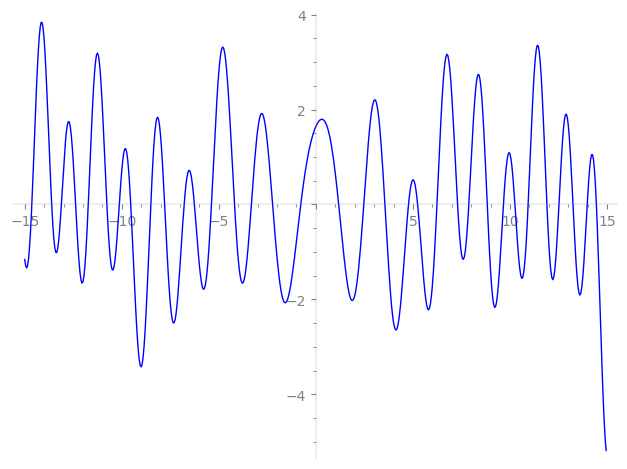| L(s) = 1 | + (−0.182 − 0.315i)3-s + (0.5 + 0.866i)5-s − 0.635·7-s + (1.43 − 2.48i)9-s − 1.63·11-s + (0.5 − 0.866i)13-s + (0.182 − 0.315i)15-s + (3.29 + 5.71i)17-s + (−0.0466 − 4.35i)19-s + (0.115 + 0.200i)21-s + (0.433 − 0.750i)23-s + (−0.499 + 0.866i)25-s − 2.13·27-s + (4.54 − 7.87i)29-s + 1.86·31-s + ⋯ |
| L(s) = 1 | + (−0.105 − 0.182i)3-s + (0.223 + 0.387i)5-s − 0.240·7-s + (0.477 − 0.827i)9-s − 0.493·11-s + (0.138 − 0.240i)13-s + (0.0470 − 0.0814i)15-s + (0.799 + 1.38i)17-s + (−0.0107 − 0.999i)19-s + (0.0252 + 0.0437i)21-s + (0.0904 − 0.156i)23-s + (−0.0999 + 0.173i)25-s − 0.411·27-s + (0.844 − 1.46i)29-s + 0.335·31-s + ⋯ |
\[\begin{aligned}\Lambda(s)=\mathstrut & 1520 ^{s/2} \, \Gamma_{\C}(s) \, L(s)\cr =\mathstrut & (0.748 + 0.663i)\, \overline{\Lambda}(2-s) \end{aligned}\]
\[\begin{aligned}\Lambda(s)=\mathstrut & 1520 ^{s/2} \, \Gamma_{\C}(s+1/2) \, L(s)\cr =\mathstrut & (0.748 + 0.663i)\, \overline{\Lambda}(1-s) \end{aligned}\]
Particular Values
| \(L(1)\) |
\(\approx\) |
\(1.647253431\) |
| \(L(\frac12)\) |
\(\approx\) |
\(1.647253431\) |
| \(L(\frac{3}{2})\) |
|
not available |
| \(L(1)\) |
|
not available |
\(L(s) = \displaystyle \prod_{p} F_p(p^{-s})^{-1} \)
| $p$ | $F_p(T)$ |
|---|
| bad | 2 | \( 1 \) |
| 5 | \( 1 + (-0.5 - 0.866i)T \) |
| 19 | \( 1 + (0.0466 + 4.35i)T \) |
| good | 3 | \( 1 + (0.182 + 0.315i)T + (-1.5 + 2.59i)T^{2} \) |
| 7 | \( 1 + 0.635T + 7T^{2} \) |
| 11 | \( 1 + 1.63T + 11T^{2} \) |
| 13 | \( 1 + (-0.5 + 0.866i)T + (-6.5 - 11.2i)T^{2} \) |
| 17 | \( 1 + (-3.29 - 5.71i)T + (-8.5 + 14.7i)T^{2} \) |
| 23 | \( 1 + (-0.433 + 0.750i)T + (-11.5 - 19.9i)T^{2} \) |
| 29 | \( 1 + (-4.54 + 7.87i)T + (-14.5 - 25.1i)T^{2} \) |
| 31 | \( 1 - 1.86T + 31T^{2} \) |
| 37 | \( 1 - 0.635T + 37T^{2} \) |
| 41 | \( 1 + (0.953 + 1.65i)T + (-20.5 + 35.5i)T^{2} \) |
| 43 | \( 1 + (-1.98 - 3.42i)T + (-21.5 + 37.2i)T^{2} \) |
| 47 | \( 1 + (-4.54 + 7.87i)T + (-23.5 - 40.7i)T^{2} \) |
| 53 | \( 1 + (-4.93 + 8.54i)T + (-26.5 - 45.8i)T^{2} \) |
| 59 | \( 1 + (-4.54 - 7.87i)T + (-29.5 + 51.0i)T^{2} \) |
| 61 | \( 1 + (1.13 - 1.96i)T + (-30.5 - 52.8i)T^{2} \) |
| 67 | \( 1 + (-6.23 + 10.7i)T + (-33.5 - 58.0i)T^{2} \) |
| 71 | \( 1 + (-1.25 - 2.16i)T + (-35.5 + 61.4i)T^{2} \) |
| 73 | \( 1 + (-0.201 - 0.349i)T + (-36.5 + 63.2i)T^{2} \) |
| 79 | \( 1 + (-5.36 - 9.29i)T + (-39.5 + 68.4i)T^{2} \) |
| 83 | \( 1 - 15.8T + 83T^{2} \) |
| 89 | \( 1 + (0.271 - 0.469i)T + (-44.5 - 77.0i)T^{2} \) |
| 97 | \( 1 + (-3.68 - 6.38i)T + (-48.5 + 84.0i)T^{2} \) |
| show more | |
| show less | |
\(L(s) = \displaystyle\prod_p \ \prod_{j=1}^{2} (1 - \alpha_{j,p}\, p^{-s})^{-1}\)
Imaginary part of the first few zeros on the critical line
−9.537669345507152489685805906150, −8.502892369316454581071261888956, −7.79127620518260029130273221218, −6.78639182218010642348030306890, −6.25903225689513976072629653470, −5.38045465545442400732225158639, −4.19230851087115433118937126327, −3.32320001743234108734477266902, −2.22977567374405704982041251548, −0.77863884657084549291050687535,
1.17328324638295893574668222462, 2.46509666603075897408587325590, 3.55540961059330807664917732286, 4.77089245090266077159286374864, 5.23996152688158024156882117476, 6.23463010184768973804357102672, 7.29787774798489539978820166208, 7.87656757120003576047606991461, 8.825519847339724879370195348861, 9.659668636137970086802080658295

